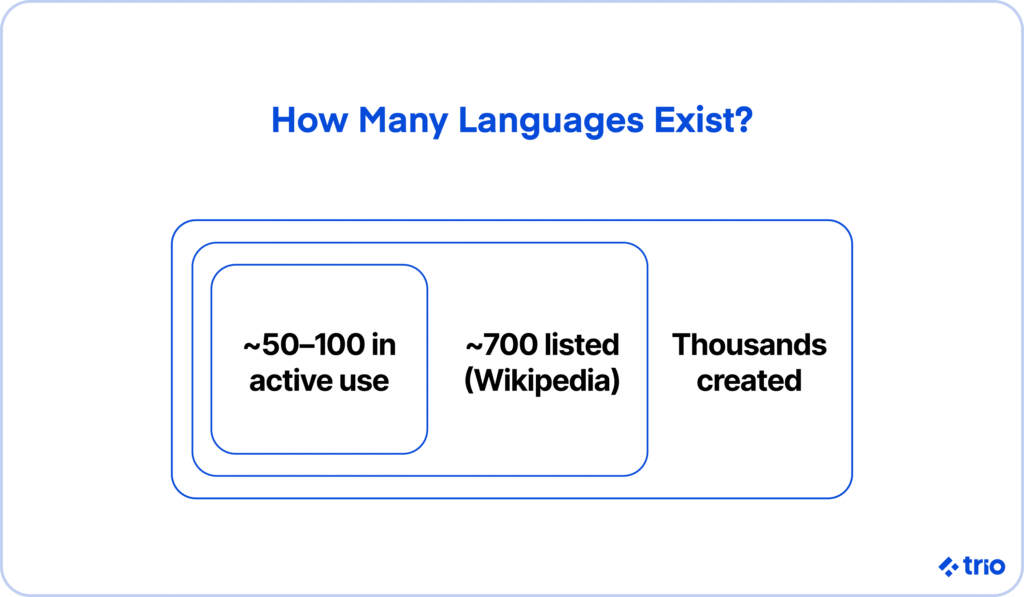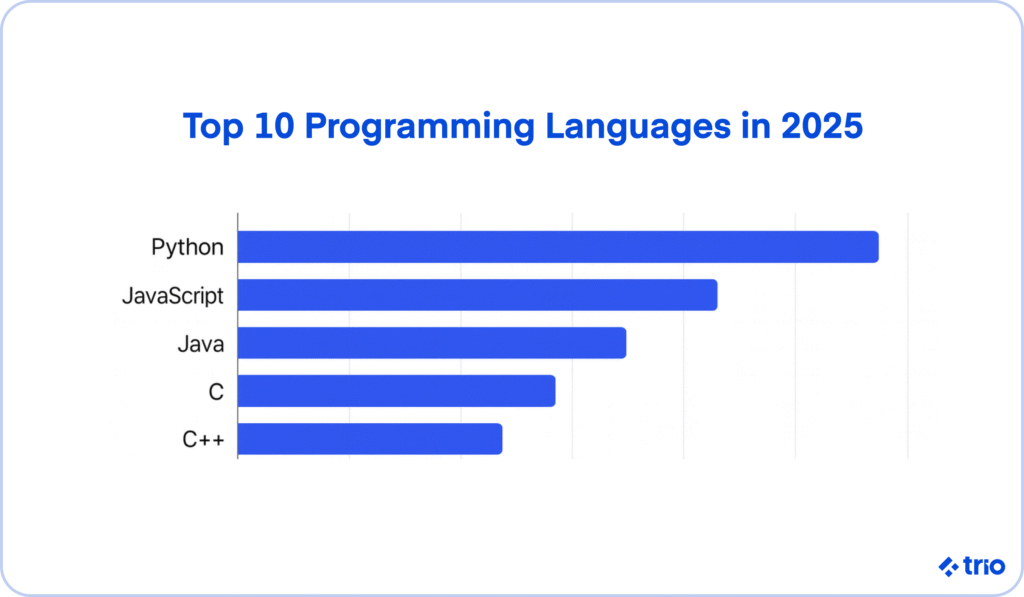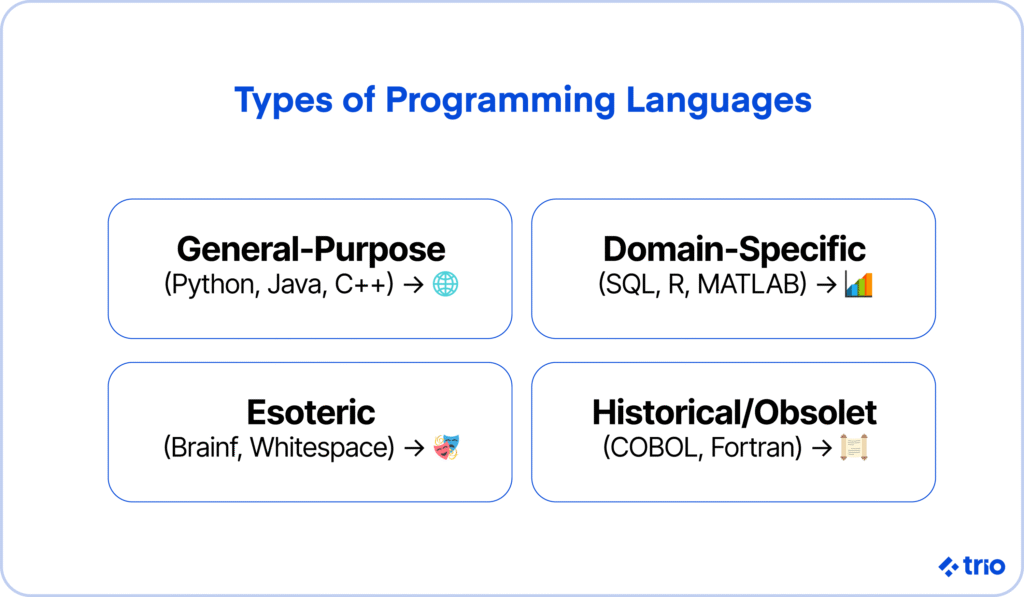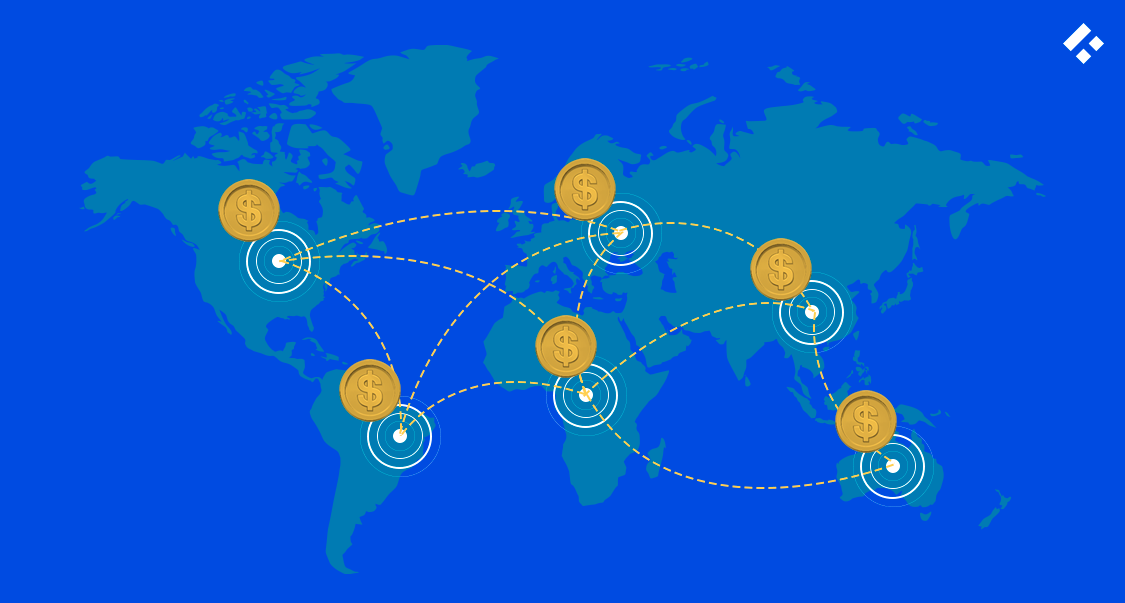When trying to figure out which programming languages are available, you can get a wide variety of answers. Some say hundreds, others thousands. A few include markup and query languages in their lists, while others don’t include some new languages that are showing incredible promise.
So, how many programming languages are there? It’s impossible to say, but it could be anywhere from a couple of hundred, which we know are in active use, to a couple of thousand if you consider all the languages that have ever been created.
Of these, there are only a few popular programming languages used by software developers for mobile app and web development. These popular languages, like Python and JavaScript, among many others, are advantageous to learn and can make a significant difference in the speed, scalability, security, and even hiring ease of a development team.
We have been in the software development game since 2019 and have been assisting companies in finding the right programmers with the right skill set for their projects. If you need extra talent and programming skills without the hassle of hiring, we can assist through staff augmentation.
If you have no technical background and don’t know where to start, we can assemble a dedicated team from scratch that will be able to launch your project, selecting the right language and other technologies while clearly communicating their reasoning by explaining core programming concepts in a way that you and any investors will understand.
Quick Answer: How Many Coding Languages Exist Today?
A variety of different authorities all count differently, but by looking at a couple of other sources, you can get a good idea of the overall list of programming languages.

Wikipedia
Wikipedia has a list that does not include esoteric programming languages or markup languages. This brings the number to around 700.
TIOBE Index
The TIOBE Index is a measure of programming language popularity.
On the primary page of the TIOBE programming community index, you can view the top 100 programming languages in the world, as measured by the site. We can assume that there are more than that.
GitHub
GitHub is a tool that is familiar to most in the programming community. There are several repositories available. Many of which are still active.
It’s difficult to say, but we estimate that there are about 50-100 that see a lot of use.
If you want to know which programming languages are used to write code today, GitHub is one of the best places to check out.
What Counts as a Programming Language?
We have mentioned a couple of times that there are certain types of languages that are widely used, but not always counted in lists of computer programming languages.
There are multiple reasons why language lists may decide to exclude some options.
Dialects and Variants
Some languages are very similar. Think of them as branches of the same tree.
C, C++, and C# are good examples of this. They are all part of the same family, but each one has its own use cases and syntax, and they may just be recorded under C and its variants.
Domain-Specific Languages
Some high-level languages are built with a very specific purpose. In some cases, these aren’t even considered to be programming languages in their own right.
There are some exceptions, though. SQL and R, for databases and statistics, respectively, are both considered to be programming languages, even though they are incredibly specialized.
Markup Languages, Scripting Languages, and Query Languages
Markup languages like HTML aren’t really used for system programming. Instead, they describe structure.
This means that they aren’t counted all the time.
Again, query languages, like SQL, are an exception and are generally considered to be functional languages.
Another confusing category in the programming world is scripting languages, which are interpreted, not compiled. This makes them great for automation and web apps. A number of programming languages, like JavaScript, Python, and PHP, are scripting languages, but they are used for a lot more.
Esoteric Languages
Esoteric languages are technically programming languages and build up a lot of lists.
However, they are often experimental or even gag languages. They aren’t used in real-world cases.
Why Are There So Many Different Languages?
Can there not be one option that everyone learns? Why are there so many different programming languages in the first place?
The simple answer is that technology changes, and with that, new issues arise that require developers to use new tools.
Each of the top programming languages in existence today was created as an improvement of its predecessor. In some cases, they improve performance. At other times, people sought something easy to learn, making programming more accessible.
Many languages have also been created with a specific use case in mind, and function optimally in those instances, but may be found lacking in others.
Some languages are designed around specific paradigms, such as imperative programming, functional programming, or object-oriented programming. All of these reasons have resulted in the incredible variety that we see today.
How Many Computer Languages Are Still in Use?
As you can imagine, programming languages have a lifespan. Not everything that has ever been created can still be used effectively.
According to the TIOBE Index, we can estimate that there are approximately 50 to 100 languages that are still in use. But the last 50 will be quite niche and only suitable for a handful of industries.
In reality, about a dozen dominate the programming market.
If you’re considering starting a project of your own, we recommend exploring these popular options. Not only are there a variety of developers to choose from, but there will also be active support and numerous resources available for your developers if they need help.
Top 10 Most Popular Programming Languages
Based on what we’ve noticed in our many years in the industry, we can safely say that some of the most popular options include:
- C
- C#
- C++
- Java
- JavaScript
- Python
- Go (Golang)
- Visual Basic
- Perl
We have experienced developers available for all these languages. Many have worked in more than one. If you’re unsure, they can advise you based on your project, ensuring you make the best overall choice.

Types of Programming Languages (with Examples)
Let’s take a look at the different types of programming languages in use, and some of the most popular examples in each of those categories.
General-Purpose
General-purpose programming languages are used to solve a wide range of problems. This means you’ll see them in most industries, powering the enterprise, scientific, and system software.
Python, Java, and C++ are all considered general-purpose programming languages.
Domain-Specific
These are more niche languages, designed for specific applications.
SQL powers relational databases, R is used for statistical computing, and MATLAB is found in computer programs that drive engineering analysis.
These developers may be more difficult to find, so choose carefully. If you have an existing team, it may be worthwhile to consider their experience in the specific domain before making a decision on which language to proceed with.
You also get operating system-specific languages. For example, you cannot necessarily use one language to code the iOS and Android versions of the same app.
Esoteric
As mentioned earlier, esoteric languages are often created as experiments or even jokes.
Brainf and Whitespace are two examples.
They are very rarely used in code that makes it to the final product, but your developers might use them to make a specific point or as a proof of concept.
Historical/Obsolete
There are several computer languages that were once very popular but are no longer used at all.
The world of programming shifts quickly. But sometimes you may still encounter these outdated languages in legacy systems.
Often, if a product continues to work well, an institution might not recode it. This only leads to issues later on, as updates and maintenance eventually become impossible.
COBOL and Fortran are two examples that are still widely used. If you’re new to programming, you may encounter them at some point. You probably don’t need to focus on learning them first, but be aware that they exist.
Similarly, if you are working with a large institution that has existing technology, offering a service that needs to integrate with their existing systems, you will need to be prepared for the challenges that legacy code will present.

Which Programming Languages Should You Learn or Hire For?
Ultimately, you want to learn a programming language or choose one for your project that can keep up with modern user requirements, is secure, and has a large community.
Most Popular for Business Use
The language you choose will depend on your industry. While there can be some overlap, in most cases we see:
- Python is used for data science, AI, and automation.
- JavaScript is used in web and mobile app development.
- Java is used in large enterprise systems.
- C# is used for Windows operating systems.
- C++ is used when you need a compiled language for very high performance.
Best for Beginners
If you are a beginner, consider which businesses are using the language and which options are the fastest and easiest to learn.
Python is probably the most beginner-friendly option. It is very simple, and it has a very large library and extensive support.
JavaScript is also very easy, and definitely the one we would recommend if you plan to do any web development.
Emerging Languages to Watch
There are some notable programming languages that are rapidly gaining popularity. Knowing where industry trends are heading can play a vital role in the decision-making process.
Rust and Go are both gaining ground.
We have seen an increase in Rust adoption as users and governments increasingly prioritize security. The language is great for reducing memory-safety bugs in some critical software.
Go, on the other hand, is making waves in cloud engineering. It has even made its way into the TIOBE index top 10!
These two ranked numbers 6 and 8 on Stack Overflow’s most desired languages in 2025, with Rust being the most admired.
Even though there are hundreds of languages out there, you only need to focus on the basics, like the top 10 and some of the emerging languages.
Want to know more about what will be best for your project, or ready to find developers?
At Tio, we have a 97% placement success rate. By hiring developers from regions like LATAM, you can get lower rates without sacrificing quality.
Reach out now to schedule a free consultation!
FAQ
How many programming languages are there in total?
It’s impossible to say exactly how many programming languages there are in total, but it could be as high as several thousand. In reality, there are approximately 50-100 that remain relevant today.
How many programming languages are actually used today?
There are approximately 50-100 programming languages that are currently in use today. The top ten hold the largest share, although the remainder is often very niche.
What are the three main programming languages?
The three main programming languages are Python, JavaScript, and Java. C and C++ are also very popular, though.
Is HTML a programming language?
HTML is not a programming language. It is a markup language. It does not provide logic or instructions, but instead structures content.
How many “C” languages are there?
There are many “C” languages, but the main ones are C, C++, and C#. Objective-C and several others are used very rarely.





